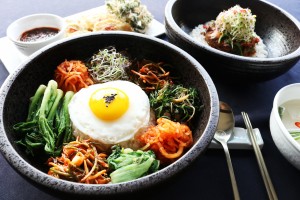 Vegetarian bibimbap has rich nutritional value and it boasts a long history behind its intentional harmony of flavors and colors.
Vegetarian bibimbap has rich nutritional value and it boasts a long history behind its intentional harmony of flavors and colors.
BIBIMBAP – the name itself means “mixed rice,” which is a pretty accurate description of the signature dish comprised of steamed rice topped with assorted vegetables.
Bibimbap is a classic, tasty, and authentic icon of Korean food. It originated from the royal table during the Joseon Dynasty [1392 – 1897] and was later passed down to the common class. Joenju claims to be the originators and is famous for their renowned, local brand of bibimbap.
The ingredients of bibimbap are intentionally chosen for purposeful harmony that appeals to both the mouth and the eyes. Rice is sweet, sautéed vegetables are salty, sesame oil is savory, is spicy, and is bitter. When finished, the mix of white, red, green, yellow, and brown create a visually appealing touch.
Here are the main ingredients you’ll need for a vegetarian bibimbap: sautéed vegetables (carrot, mushroom, zucchini, bean sprouts, lettuce, chard, spinach, green onion), sauces/ seasoning (gochujang, sesame oil, soy sauce, garlic, vegetable oil, ginger). It’s everything you need for a balanced meal with an abundant source of protein, vitamin, minerals and fat.
Similar to the vegetarian jook and pajeon I introduced previously, there are endless variations to match your likings. I like to add tofu to the mix – fresh or fried, depending on my mood -. It can be served in a hot stone bowl (dol sot bibimbabp) with a sizzling egg on top for a perfect finish.
Overall, I appreciate the rich nutritional value, intentional harmony of flavors and colors, and the long history behind bibimbap; no wonder why this beloved dish is internationally well-known now.
By Hajin Lily Yi


![Asian Voters’ Support for Trump Rose to 40%, Pew Survey Shows U.S. President Donald Trump delivers an address to the nation accompanied by U.S. Vice President JD Vance, U.S. Secretary of State Marco Rubio and U.S. Defense Secretary Pete Hegseth, at the White House in Washington, D.C., U.S. June 21, 2025. [REUTERS]](https://www.koreadailyus.com/wp-content/uploads/2025/06/0626-Trump-100x70.jpg)

